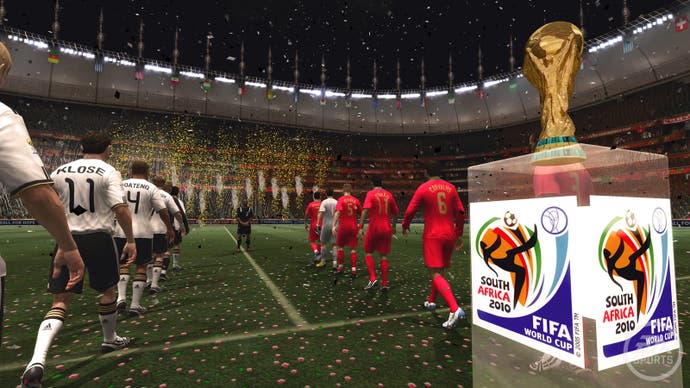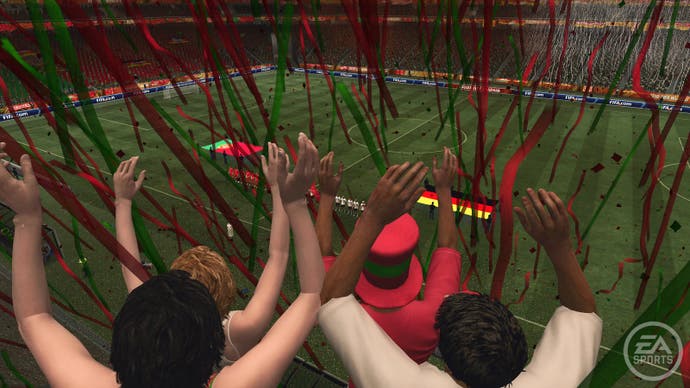2010 FIFA World Cup
Terry and June.
Everyone's wrong about John Terry. It wasn't shagging a team-mate's former missus that cost him the England captaincy. It was the Curse of FIFA.
It's the week before Terry-gate is splashed all over the news and I'm sat in a stuffy conference room in Stamford Bridge, home of Chelsea FC. Simon Humber, line producer on 2010 FIFA World Cup, is coming to the end of his presentation and tells us he's got something special he wants us to see before we wrap up.
A video plays. It's full-time in the World Cup final. England have beaten Germany! Amazing scenes as fireworks burst, confetti rains down and a nation ejaculates after 44 years of hurt. As the commentary team exchange increasingly desperate clichés, Fabio Capello dances around his proud lions as Michael Ballack sobs into the battle-scarred turf.
The trophy is handed over to leader and hero John Terry, who holds it aloft in the blazing South African sunshine, before showering it in kisses as his band of brothers caper around him.
Nine days later, back in the real world, John Terry is humiliatingly sacked as captain. There's tempting fate and there's showing John Terry slobbering all over the World Cup at the ground where he's also club captain. See? The Curse of FIFA. Or, is it actually the Revenge?

It's a World Cup year so there's a World Cup game, which raises the usual set of questions about content and value, with release coming smack bang between FIFAs 10 and 11. But the outstanding quality of last year's entry is enough to raise excitement about what might be new and improved, since EA's FIFA factory in Vancouver (which we visited last year ) routinely debuts new features and gameplay enhancements in the Euro and World Cup support slots which become staples of the main act.
As Humber puts it to me, "The mere fact that this is a more refined, enhanced, more responsive version of our gameplay engine" should be enough to tantalise FIFA fans. Well, let's see.
"We've made over 100 enhancements to gameplay," Humber adds. An impressive-sounding figure, but what does it mean in reality? First, the fixes. Problems with goalies coming off their lines have been addressed, as have those with chipped shots and controlling aerial balls, so players should now chest and move without freezing mid-animation. It's all about "fluidity".
As EA's familiarity with the current iteration of the FIFA engine grows, the team has found new ways to play around with ball dynamics in relation to air resistance. South Africa has several stadia over 1500m above sea level. At this altitude there's less oxygen, so the ball moves through the air faster due to a lack of resistance, but this scuppers swerve and makes it harder to keep long-range shots down. It's also likely that teams used to playing at lower altitudes will tire faster towards the end of a match.

Elsewhere the effect will be greater still, with South American venues in Columbia, Ecuador and Bolivia reaching up to a sky-scraping 4500m. Humber cites Argentina's 6-1 trouncing by Bolivia in support of the role altitude can play, but stresses these effects will be applied with subtlety in-game.
"It's important people don't think we're coming up with some caricature version of football for Bolivians who might want to play our game," says Humber. In your face, Bolivians.
The most obvious changes are aesthetic and structural. This is the official game of the World Cup and EA is obliged to reflect this with the content. 199 national sides are included, and each squad comprises 23 players "plus some fringe players," says Humber. "Up to about 40 depending on the team, so you can mix and match."
A great deal of effort has gone on recreating the carnival atmosphere of a World Cup - which was the ostensible point of showing England's fantasy win during the presentation. In addition to victory pyrotechnics, cameras flash, there are seat cards for fans to hold aloft before kick-off, and every nation has its own 3D crowd close-up for those moments when the TV director is struggling to find another pair of teenage breasts to point a camera at. Pissed-up, sunburnt hooligans throwing chairs at foreigners in England's case, no doubt.


